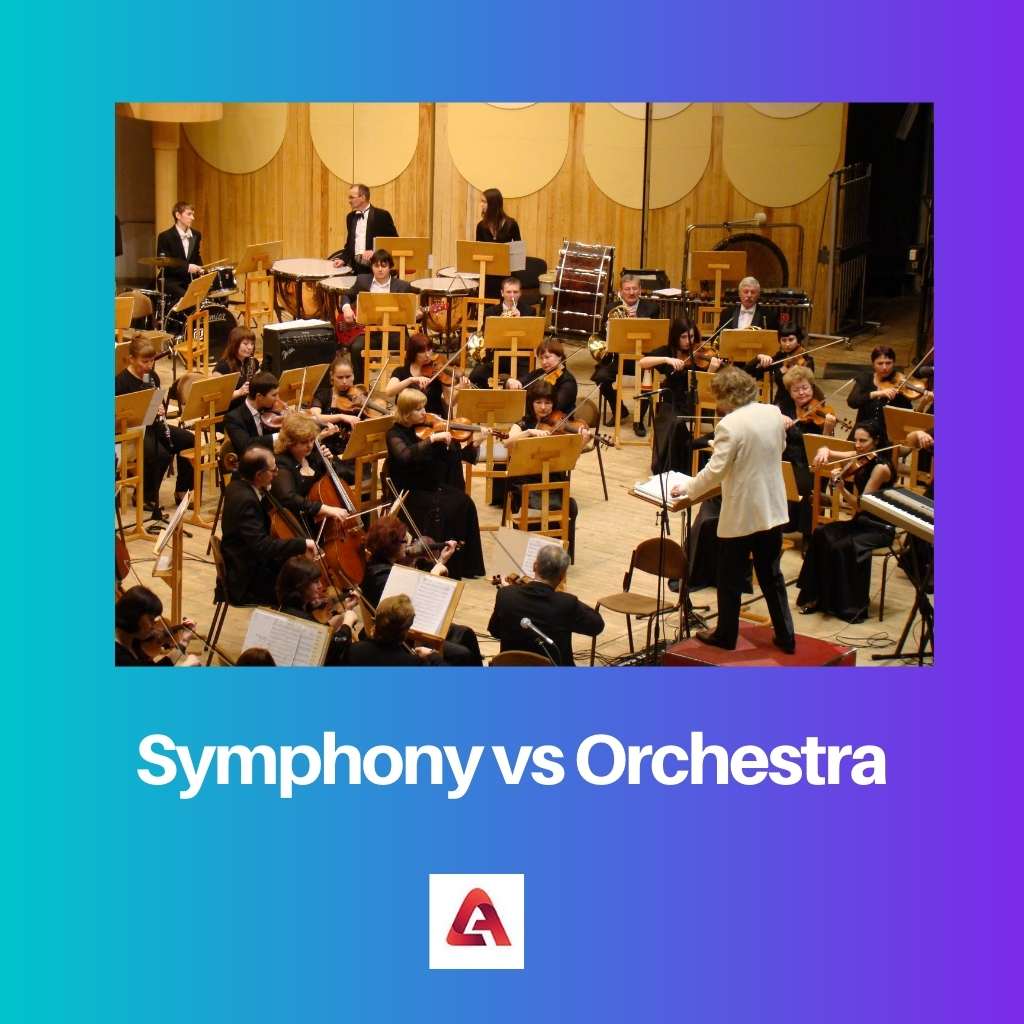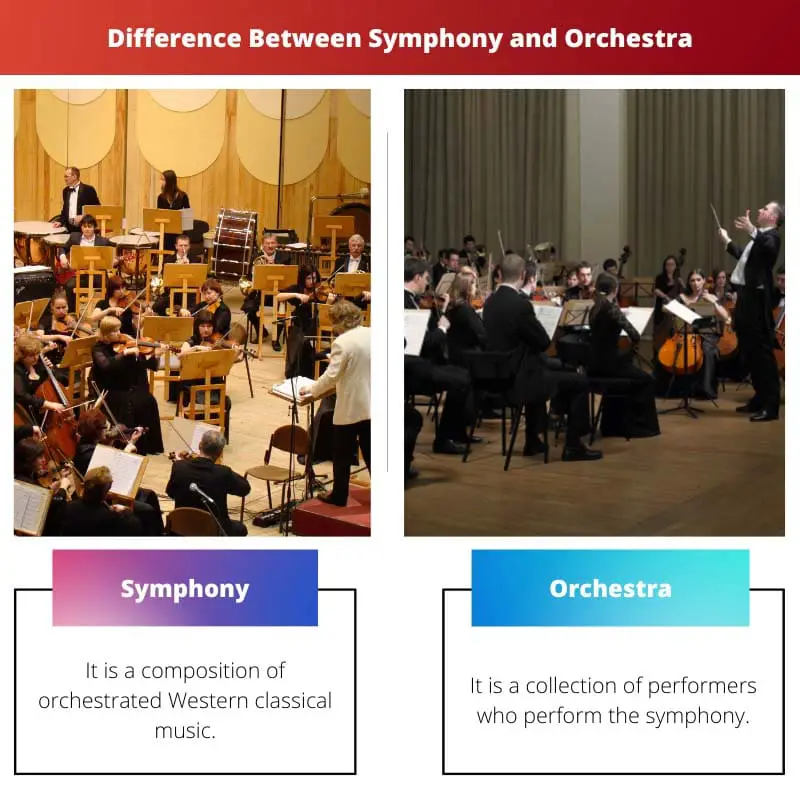Western classical music includes both the Symphony and the Orchestra. Western classical music is the formalized artistic heritage of the West, as opposed to Western folk music and contemporary music.
Classical music is distinguished by its intricacy in musical structure and harmonic arrangement, particularly when polyphony is employed.
Key Takeaways
- A symphony is a musical composition, for a full orchestra, while an orchestra is a large ensemble of musicians who perform symphonies and other works.
- Symphonies have multiple movements and showcase various instruments, while orchestras consist of musicians playing string, brass, woodwind, and percussion instruments.
- The conductor leads an orchestra in performing symphonies and other compositions, ensuring proper tempo, dynamics, and interpretation.
Symphony vs. Orchestra
The difference between a symphony and an orchestra is that a symphony is a form of music, whereas an orchestra is a group of musicians that play the symphony. A symphony is a huge orchestral piece composed of three or four movements. An orchestra is a group of musicians who perform a range of pieces, notably violins and other violin-related instruments.

A symphony is a massive orchestral work with several movements, one of which is in sonata style.
Haydn and Mozart established the traditional form of the symphony, but later composers’ modifications have completely liberated it from traditional restraints.
It has remained a platform for significant, large-scale symphonic music.
An orchestra is a large symphonic ensemble in classical music composed of instruments from the four basic components of European instrumentation: strings, brass, winds, and percussion.
A symphony orchestra is a term used to describe a full-size Western orchestra.
The number of musicians used in a particular concert might range from seventy-five to more than one hundred.
Comparison Table
| Parameter of Comparison | Symphony | Orchestra |
|---|---|---|
| Definition | It is a composition of orchestrated Western classical music. | It is a collection of performers who perform the symphony. |
| Etymology | Derived from the Greek word “Symphonia” which means an agreement of sound. | Derived from the Greek word “Orchestra” which is the name of the area in front of the stage. |
| Origin | Around the 1700s, symphonies evolved from Italy’s Neopolitan School, established under Alessandro Scarlatti, as openings for operas. | The first modern orchestra was formed in the early 1600s when Claudio Monteverdi assigned specific instruments to play his works. |
| Person responsible | It is written by a composer. | It is guided by a conductor. |
| Played by | 30-70 musicians | Strength of about 100 |
What is Symphony?
A symphony is a long piece of Western classical music, written for an orchestra. The term “symphony” is evolved from the Hellenic term “Symphonia,” which means “accord or harmony of sound” or “concert of the choral or acoustic musical”.
When a symphony is performed by an orchestra, it is referred to as a “symphony orchestra”. It is large enough and has diverse enough instrumentation to perform a symphony.
They’re composed for a huge orchestra of 30 to 100 players, including a string group, trumpet, clarinet, and tambourine instruments.
Symphonies are written down in a musical score that includes all of the instrument parts. Orchestral artists perform from sections using just transcribed melody for their equipment.
Vocal sections can be found in some of them, such as Faust Symphony of Franz Liszt.
Originally, symphonies alluded to just about any composition of orchestral music for a large group, whether it was played as part of an opera or as a stand-alone work, with the introduction of classical music in the 17th century.
The symphony follows a rhythm of four movements, namely, fast, slow, minuet/dance movement, and fast in sonata form.
Rules are made to be broken, and few of the finest symphonic artists, such as Beethoven, regularly deviate from this norm. During the Romantic Movement in the nineteenth century, the craze for symphonies increased among people.

What is Orchestra?
The term “orchestra” refers to any band that includes a large number of string instruments. There are two types of orchestras: chamber orchestras, which are smaller in size, and symphony orchestras, which are huge.
Chamber orchestras have 50 or fewer musicians, who mostly play string instruments. They perform “chamber music,” as the name suggests, which is older music intended for private rooms, aristocratic parlors, and flashy castle apartments.
Composers continued to write chamber music, but the genre flourished between the 1740s and 1820s when wigged songsters like Haydn, Mozart, and Vivaldi ripped up the scene.
A symphony orchestra, on the other hand, is a big orchestra composed of winds, strings, and percussion that performs symphonic pieces. It might have anything from 70 to 100 performers.
They are guided by a conductor. A conductor leads a performance using hand and arm gestures. These gestures are aided by the deployment of a conductor’s baton.
The conductor unites the ensemble, establishes the pace, and determines the group’s style.
The conductor also helps the orchestra rehearse for the concert through organising sessions before the live performance, throughout which he gives advice to the performers on how to perceive the work.
Instruments used in orchestras have developed over time to incorporate contemporary technology and aesthetic trends.
Today’s orchestras are made up of the following members: strings instruments, wind instruments, brass instruments, and percussion instruments.

Main Differences Between Symphony and Orchestra
- A symphony is a type of musical composition, whereas an orchestra is a gathering of musicians that play various musical compositions including symphony.
- The word symphony comes from the Greek word “Symphonia,” meaning “sound agreement,” whereas “orchestra” comes from the Hellenic term “orchestra,” which refers to the area at the front of the theatre.
- Symphonies evolved in the 1700s under Alessandro Scarlatti, as openings for operas. The orchestra started in the 1600s when Claudio Monteverdi explicitly allocated certain instruments to perform his work.
- A symphony is a single composition of orchestral melody for a big ensemble. On the contrary, an orchestra is made up of several diverse types of instruments.
- A symphony is authored by a composer, such as Beethoven or Wolfgang, whereas an orchestra is led by a conductor, such as Carlos Kleiber or Leonard Bernstein.


It’s interesting how the symphony and orchestra are distinctly different yet intertwined. Great read.
Indeed, the historical context brings a whole new perspective to these musical forms.
This truly made me appreciate classical music even more.
Love the introduction to the comparison! More articles like this would broaden my musical horizons.
I think there’s a lot more to cover on the differences between symphony and orchestra. The article feels incomplete.
I actually appreciate the brevity. A deeper dive into minutiae could become overwhelming for the average reader.
While the article could touch upon more specifics, it does provide a solid foundational understanding. It’s a balancing act.
An outstanding exposition. Very informative and educative.
The level of detail here is mesmerizing! Thanks for the thoughtful analysis
Couldn’t agree more. The author has done an amazing job explaining complex concepts.